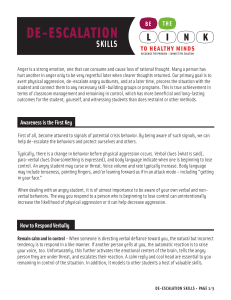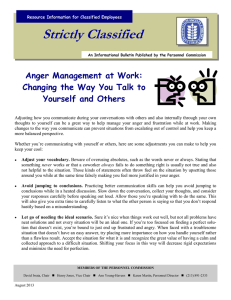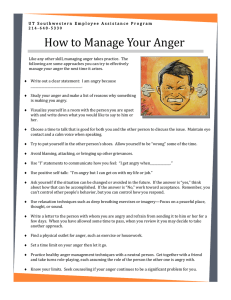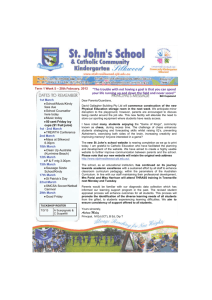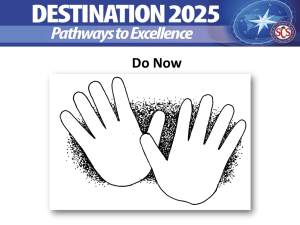De-Escalation and Pro-active Communication Skills
advertisement
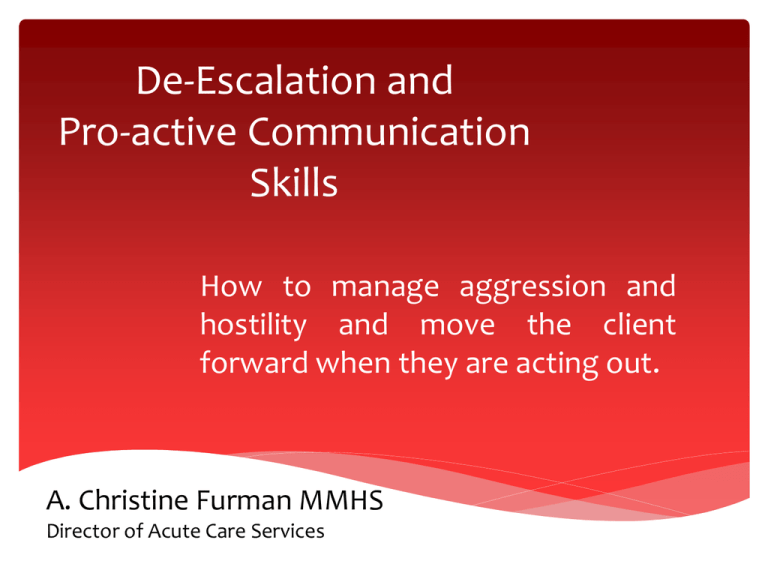
De-Escalation and Pro-active Communication Skills How to manage aggression and hostility and move the client forward when they are acting out. A. Christine Furman MMHS Director of Acute Care Services What we are going to talk about: Recognizing aggression and hostility Communication Skills Non-verbal Communication Skills Diffusion Strategies De-escalation techniques and skill Why do people escalate and become aggressive or hostile? Frustration Feel that they have been treated unfairly Feel that they have been humiliated They are immature There is a level of excitement they are reacting to It works – it is a means to an end It is part of their reputation Aggression and Hostility may be symptoms of their mental illness How do you know when someone is feeling hostile or aggressive? They may stand taller Their face may redden Their voice may raise They may breath faster They may make prolonged, direct eye contact with you – stare you down They may make exaggerated gestures They may become very tense They may begin to pace They may clench their fists They may clench their jaw and tighten their facial muscles Behavior is different than normal Communication This is a two way process that includes: Listening Speaking, and Hearing As a staff member you will also need to: Observe, and Interpret Some things that get in the way of effective communication are: Background noise, and having to speak loudly (are you having to yell?) Inappropriate setting Language barriers Perception and Prejudice Intrusion of personal space Time constrains Lack of encouragement Twelve Roadblocks to Listening – Thomas Gordon, Ph.D. 1. 2. 3. 4. 5. 6. 7. 8. 9. 10. 11. 12. Ordering, directing, or commanding Warning or threatening Giving advice, making suggestions, or providing solutions Persuading with logic, arguing, or lecturing Moralizing, preaching, or telling clients what they ‘should’ do Disagreeing, judging, criticizing, or blaming Agreeing, approving, or praising Shaming, ridiculing, or labeling Interpreting or analyzing Reassuring, sympathizing, or consoling Questioning or probing Withdrawing, distracting, humoring, or changing the subject Escalation Prevention Steps: Prevention Step #1 Staff need to be able to recognize early warning signals such as: • Behavior changes • Quiet people become agitated • Loud people become quiet Commenting on the changes may open up conversation and minimize frustration or anger build up – giving the client an opportunity to diffuse the situation. Prevention Step #2 Recognize that Anger is a normal emotion – we don’t always need to fix it or be afraid of it – unless the person becomes a danger. Anger is not ‘normal’ when: Anger is often used to get ones way Anger is often used to get attention to escape a situation to gain control of a situation Anger is used to pump one’s self up when feeling small or insecure Prevention Step #3 Staff need to remain in touch with their emotions when dealing with an angry client. If you become angry or defensive you will not be able to help the client. If you cannot manage your emotions and remain calm and objective, you will need to get help. Prevention Step #4 Take a deep breath, and attempt to remind yourself of the following: • Avoid criticizing and finding fault with the aggressive person. • Avoid being judgmental with the aggressive person. • Use a calm, steady voice without and edge or sing song. • Do not become involved in the conflict. • Be able to try to see the situation from the angry person’s point of view. • Remember that your job is the health and safety of your client. • Have a plan. What should staff do once a client has Escalated? Take deeper breath Appear confident – but not cocky Remain calm Show that you are listening Speak slowly, gently and clearly Avoid arguing and confrontation Create space between you and the agitated person Know how you are going to get out of the area Adopt a non-threatening body posture Use a calm, open posture – either sitting or standing Reduce direct eye contact – do not stare Allow the person adequate personal space Keep both hands relaxed and visible Avoid any sudden movements Avoid and discourage an audience De-Escalation Techniques Explain your purpose or intention Give clear, brief, assertive instruction Negotiate options Ensure that your non-verbal communication is non-threatening De-Escalation Technique #1 Just Listen Sometimes all it takes to de-escalate someone is a good ear and the time to allow the client to vent. Just listen to what they have to say and give them encouragement. Technique #2 Acknowledgement This is when you really listen and are able to relay back to them that you understand what they are feeling. “I understand that you are angry” “I see that you are frustrated” “You feel that you have been wronged” Technique #3 Allow Silence You don’t need to be the problem solver. It’s not your job to have all the answers. Give the client time to reflect, don’t fill the time with your thoughts and questions. Just be with them, calmly. Technique #4 Apologize If the situation was unjust or unfair – a sincere apology is powerful. It does not mean that you are accepting blame, it means you are acknowledging that something that occurred wasn’t right or fair. Technique #5 Invite Criticism Ask what you/we/the program could do better, be sincere. Don’t tell them why it won’t work or why it’s not a good idea, just listen and thank them for their input. This may intensify someone’s anger temporarily – but if you encourage them to continue and let them be heard the conversation tends to end on a more positive note. Technique #6 Develop a Plan You should have a plan at the ready, for example… a place for a time out, a meeting with a supervisor or case manager; however you will want to work out the options with the client. Never Threaten Once you have threatened or given an ultimatum all negotiations will cease and you will be in a win/lose situation. Try to keep options as open as possible. Ultimate Plan for Safety • Do you have a plan if you can’t de-escalate a client? • Does your agency? • Does your agency have P&P regarding safety? • Do you have a way to summons others for help?

